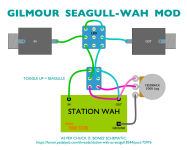A little background first. When David Gilmour recorded that famous "seagulls in outer space" tone, the CryBaby had the classic two transistor design. Same as the Tear Jerker, but without the DIP switch and trimpots. The output is taken off of the collector of the 1st transistor. This point is inside the feedback loop that controls the filter freq and it has a high impedance. The high impedance makes it sensitive to loading and the location inside the feedback loop means it could, under the right conditions, lead to oscillation. Guitar pickups are highly resonant and the tone control affects the resonant frequency in a big way. By happy accident, Gilmour discovered what happens when you connect a guitar to the CryBaby's output jack. The entire circuit breaks into oscillation and that signal is present pretty much everywhere. The input jack is one place to pick up the signal, but you could just as well get it from the output jack or other places in the circuit. When I tried hooking my GCB-95 backwards, I got the seagull tone, which surprised me because that design has a 3rd transistor installed as an input buffer. It's the same circuit as the Station Wah. The Seagull tone passes backwards thru Q1. If you want to be able to control the volume of the Seagull tone, then a good place to pick-off the tone is at or near the collector of Q2. I recommend connecting an A500K pot with pin 3 at the board output, pin 2 goes to the Gilmour switch and pin 1 to ground.
Here are the details of how to do it with the Station Wah. Other CryBaby derivatives such as the Tear Jerker and ShamWah can be implemented in a similar fashion. Only 2 new parts: VR2 and S2.
View attachment 15910

